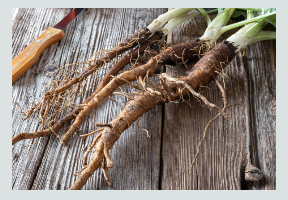Burdock leaf cut & sifted
Burdock leaf cut & sifted
Couldn't load pickup availability
Burdock
Arctium lappa
Burdock leaf is one of the best all around treatments for problems with bacterial or fungal infections. It's found in Europe and Asia and has been used by the Chinese and Japanese for many years to treat all kinds of problems such as colds and flu. It has also been used to treat problems with the kidneys.
Burdock is a member of the daisy and sunflower family, although its appearance immediately indicates its place in the thistle group of plants. Attractive and sturdy, burdock is most likely to be found on the roadside and other undisturbed places. The “dock” portion of its name speaks to the large, downy leaves of the plant, which are used fresh to make poultices or harvested and dried to make bitter teas and tonics. While the entire plant contains antioxidant compounds such as quercetin and inulin, they are concentrated in burdock roots collected from first year plants. Dried and powdered arctium lappa root are used to prepare topical skin formulations as well as teas and tinctures.
a bit of botany
a little botanical information about burdock
description
Arctium lappa, or burdock, is a biennial plant in the Asteraceae family. Burdock is rather tall, reaching as much as 9 feet (2.7 m). It has large, alternating, cordiform leaves that have a long petiole and are pubescent on the underside. The flowers are purple and grouped in globular capitula, united in clusters. They appear in mid-summer, from July to September. The capitula are surrounded by an involucre made out of many bracts, each curving to form a hook, allowing them to be carried long distances on the fur of animals. The fruits are achenes; they are long, compressed, with short pappuses. The fleshy tap-root can grow up to 3 feet (0.91 m) deep.
common names & nomenclature
Burdock comes from the Middle English burre from Scandinavian; akin to Danish burre, Swedish borre – referencing the burr that can stick to animal fur to be carried long distances.
Also known as:
greater burdock, gobo, edible burdock, lappa, beggar’s buttons, hardock, hurrburr, happy major, hareburr, philanthropium, niu bang zi, turkey burrseed, fox’s clote, bardana, cocklebur, personata, grass burdock, clotbur, burr seed, cockle buttons, lappa, thorny burr, love leaves
Additional information
burdock leaf fights fungus and battles bacteria
Burdock leaf actually has three major benefits: it's an antibacterial agent, an antifungal agent, and it works as a diuretic. These three functions come together to provide you with the power you need to fight disease.
As an antibacterial agent, burdock leaf can do many things. First, you can use it topically to treat minor skin problems such as bruises and scrapes. It can also help to speed the healing of burns and protect you from infection. When skin is burned, it leaves you much more vulnerable to bacterial invasion.
Burdock can also be used topically on the skin to help treat acne. Acne is actually a tiny bacterial infection under the skin. When you use burdock, you help to kill off the bacteria and give your skin a chance to heal.
As an antifungal, burdock is helpful in relieving conditions such as athlete's foot. It can also treat skin irritations like eczema and psoriasis. Some people even use burdock to treat tumors on the skin. It does seem to help treat those tumors and give you long term relief.
If you have problems with diarrhea, you'll want to avoid burdock until everything returns to normal. That's because it works as a diuretic and combined with diarrhea could cause you to be dehydrated.
You can take burdock leaf in the form of a tea, powder, capsule, or tincture. You can also find burdock in lotions and creams that are used for the skin. You may have never used burdock leaf, but it's a good broad-spectrum herb to keep in supply. You'll find many uses for it and you'll be astounded by its success.
Formulas & recipes
What is burdock root?
Burdock root is a wild plant and can be found on the side of the road in some areas. It is considered a nuisance to some, but for those who know how to prepare burdock root, it is considered extremely valuable. Burdock root benefits range from acne prevention to decreasing liver toxicity.
How to use burdock root
There is an extensive list of burdock root recipes out there. Burdock root can be used in the kitchen by adding flavor to soups, stews, braised meat, and more. Burdock root can also be used to make a super simple tea.
How to make burdock root tea
-Add 2 teaspoons of burdock root herb to a tea bag
-Pour 8 ounces of boiled water over the tea bag
-Let steep for 10-20 minutes, as burdock root tea takes a little longer to flavor the water
-Add sugar or other desired sweetener and enjoy
Apart from the kitchen, there are many other burdock root uses. The herb comes in many different forms and can be used in a variety of cosmetic products. When tinctured with witch hazel, it can be used topically. The dried root can be used in face washes and poultices. Our burdock can be purchased in a variety of forms based on your herbal needs.
Is burdock leaf edible?
Yes! The burdock leaf is fine to eat and has many topical uses as well. Sometimes burdock leaf is used in salads for added nutrients. The leaves tend to be a bit bitter, but the stems of the herb can offer a sweeter taste when added to dishes as well.
Share




